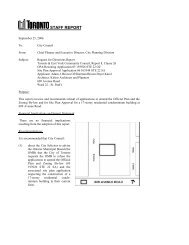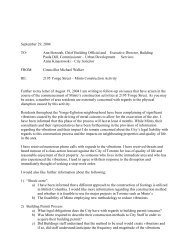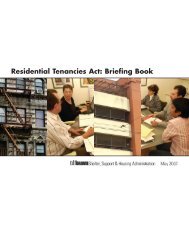Residential Tenancy Reform Consultation Paper
Residential Tenancy Reform Consultation Paper - Michael Walker
Residential Tenancy Reform Consultation Paper - Michael Walker
Create successful ePaper yourself
Turn your PDF publications into a flip-book with our unique Google optimized e-Paper software.
Rent increase guideline<br />
RESIDENTIAL TENANCY REFORM CONSULTATION PAPER<br />
The rent increase guideline is the maximum percentage<br />
by which landlords are generally authorized to raise<br />
rents without seeking approval from the Ontario Rental<br />
Housing Tribunal (the Tribunal). Many tenant advocates<br />
and others have maintained that the guideline is too high.<br />
Achieving the government’s desired objective of strengthening<br />
rent controls requires an examination of how the<br />
guideline is calculated.<br />
Background:<br />
The rent increase guideline applies to most residential rental<br />
accommodation (excluding units built since 1991 and all<br />
social housing). The guideline is calculated by taking a base<br />
amount of 2 per cent and adding an amount that reflects<br />
the average increase in building operating costs. The Tenant<br />
Protection Act, 1997 (TPA), sets out how the part of the<br />
guideline that is related to building operating costs is to be<br />
calculated. Every year the government publishes the Rent<br />
Control Index (RCI) 1 , which is a three-year average of the<br />
increases in the eight operating costs that affect most landlords.<br />
Fifty-five per cent of the RCI is the amount included<br />
in the guideline, because that is the typical operating costto-revenue<br />
ratio for Ontario’s apartment buildings.<br />
Table 1: Rent Control Guideline and Inflation, Ontario<br />
6.0%<br />
5.0%<br />
Since 1991, this calculation method has generally resulted<br />
in guidelines exceeding the rate of inflation, as indicated<br />
in Table 1. (In periods of high inflation, this formula would<br />
tend to result in guideline increases below inflation.)<br />
The TPA does not specify what the 2 per cent base<br />
amount is for; landlords may argue that it provides a<br />
return on their investment in rental housing, while tenant<br />
stakeholders generally characterize it as a bonus for landlords.<br />
The 2 per cent base was established in 1987 when<br />
inflation was substantially higher (average inflation from<br />
1988-1990 was over 5 per cent). Current inflation is<br />
approximately 2 per cent (average inflation from 1999-<br />
2003 was 2.2 per cent). The federal government and<br />
Bank of Canada have an inflation target range of 1-3 per<br />
cent, and monetary policy is aimed at keeping inflation at<br />
the 2 per cent target midpoint.<br />
Increasing vacancy rates have made it more difficult for<br />
landlords to raise rents, and as Table 2 indicates, this has<br />
caused average rent increases for vacant units to be less<br />
than the rent increase guideline. Therefore, the rent<br />
increase guideline has had a limited role in determining<br />
rent increases in 2002 and 2003. In previous years, the<br />
rent increase guideline was lower than the average rent<br />
increases in vacant units in major cities, such as Toronto,<br />
Ottawa, Kitchener and Oshawa.<br />
Table 2: Greater Toronto Area 1998 to 2003<br />
4.0%<br />
3.0%<br />
2.0%<br />
1.0%<br />
7.0%<br />
5.0%<br />
1998 1999 2000 2001 2002 2003<br />
0.0%<br />
-1.0%<br />
1991 1992 1993 1994 1995 1996 1997 1998 1999 2000 2001 2002 2003<br />
CPI (inflation)<br />
Guideline<br />
3.0%<br />
1.0%<br />
1. The eight costs measured are: heat, water, hydro, municipal property<br />
taxes, insurance, maintenance, administration and miscellaneous costs.<br />
-1.0%<br />
Average Rent Increase<br />
Vacancy Rate<br />
Rent Increase Guideline<br />
8






